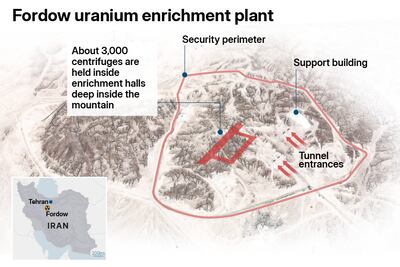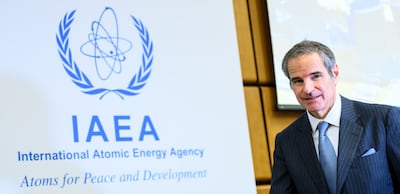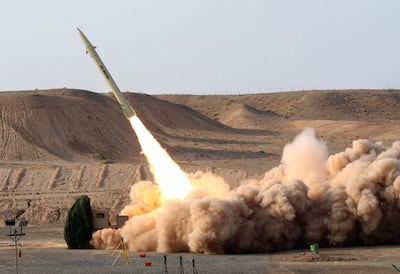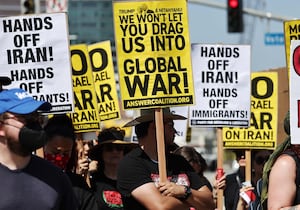Iran will not be able to make a nuclear bomb “for years”, even if it has managed to protect its enriched uranium from air strikes, analysts have told The National.
They have concluded that the damage inflicted by US bombers to the Fordow plant, where centrifuges could enrich uranium to a high enough purity for a bomb, will have severely damaged its capabilities.
However, following reports that Iran has managed to remove 400kg of its 60 per cent enriched uranium out of Fordow, there is a belief that it would allow Tehran to continue its nuclear programme once the bombing stops.
The stakes in what happens next to the residual programme could not be higher. Britain’s Foreign Secretary David Lammy said that “strikes cannot destroy the knowledge Iran has acquired over several decades, nor any regime ambition to deploy that knowledge to build a nuclear weapon”.
In a statement to Parliament he added that “once you have the ability to enrich uranium to 60 per cent that knowledge is not lost, it is the step to an advanced weapon”.
He also called for Tehran to “dial this thing down and negotiate” as the alternative was “even more destructive and far-reaching conflict, which could have unpredictable consequences”.
Years out
Steps to weaponising uranium will have become harder for Iran. Without getting the uranium to 95 per cent enrichment it is impossible to create a chain reaction and a nuclear explosion, said nuclear weapons specialist Hamish de Bretton Gordon.
“Turning that enriched uranium into weaponised uranium at 95 per cent would require a facility with centrifuges and all the other paraphernalia,” he said.
“These are very complex pieces of equipment and you need the knowledge to make them work. My assessment is that Iran doesn't have the capacity to make a nuclear device and is unlikely to do so for some considerable time, for years.”
IAEA nuclear inspectors have suggested that Iran would “adopt special measures” to protect its programme in the event of war and that the regime had already notified them of a new enrichment site which they were due to inspect before the Israeli attack began.
But Rafael Grossi, IAEA director general, also suggested that the American bombing had now devastated the programme. “Given the explosive payload utilised, and the extreme vibration-sensitive nature of centrifuges, very significant damage is expected to have occurred,” he said.
Assassination effects
Intelligence reports suggest that Iran was close to enriching uranium to 95 per cent within three days using the Fordow centrifuges, but with these now destroyed that will be difficult to achieve.
Israeli intelligence is reported to know that Iran has some highly enriched uranium hidden, probably at Isfahan, which was one reason for their bombing campaign.
Iran will also need to rebuild facilities and, while this could take months, many of the parts will have to be imported with, intelligence agencies on high alert.
Iran has suffered the killings of up to 17 nuclear scientists along with destruction of research papers and laboratories. While it will have some corporate knowledge left over, this will be difficult to rebuild.
Labs gone
The main problem for Iran is that it needs to turn enriched uranium hexafluoride back into solid metal which requires the laboratories and factories that have now been destroyed.
Israeli and US intelligence service appear to have infiltrated the regime, making it possible that Iran’s adversaries will know or can find out where the uranium has gone.
Mr de Bretton Gordon, a former British Army colonel, admitted that “you can hide uranium fairly easily as it doesn't emit really strong, powerful radiation” and if it was bombed it would cause very little radiation fallout.
But Marion Messmer, nuclear expert at Chatham House think tank, said that Fordow and other enrichment sites attacked are unlikely to be all the Iranian programme.
She claimed that the attacks would “embolden Iran in its pursuit of nuclear weapons as they will likely be seen now as the only security guarantee”.
Darya Dolzikova, a nuclear specialist at the British Royal United Services Institute think tank, added that the physical elimination of the programme’s infrastructure and assassinations “will not be sufficient to destroy the latent knowledge that exists in the country”.
Dirty bombs
At best Iran could rapidly produce an “improvised nuclear device” using the 60 per cent enriched uranium but this would amount to no more than a dirty bomb that would simply spread radiation around an area without particularly deadly effect.
Dr Messner said that while a dirty bomb only required a conventional payload and some radioactive material, this would go against Iran’s goal of a nuclear arsenal. “Using some of its limited stockpile for a dirty bomb would be a waste,” she said. “And the consequences of using a dirty bomb against Israel would also likely be very severe. A dirty bomb is not a deterrence capability.”
UAE currency: the story behind the money in your pockets
Results
5pm: Maiden (PA) Dh80,000 (Turf) 1,200m, Winner: ES Rubban, Antonio Fresu (jockey), Ibrahim Aseel (trainer)
5.30pm: Handicap (PA) Dh85,000 (T) 1,200m, Winner: Al Mobher, Sczcepan Mazur, Ibrahim Al Hadhrami
6pm: Handicap (PA) Dh80,000 (T) 2,200m, Winner: Jabalini, Tadhg O’Shea, Ibrahim Al Hadhrami
6.30pm: Wathba Stallions Cup (PA) Dh70,000 (T) 2,200m, Winner: AF Abahe, Tadgh O’Shea, Ernst Oertel
7pm: Handicap (PA) Dh85,000 (T) 1,600m, Winner: AF Makerah, Tadhg O’Shea, Ernst Oertel
7.30pm: Maiden (TB) Dh80,000 (T) 1,600m, Winner: Law Of Peace, Tadhg O’Shea, Satish Seemar
Company%20profile
%3Cp%3E%3Cstrong%3EName%3A%3C%2Fstrong%3E%20WonderTree%3Cbr%3E%3Cstrong%3EStarted%3A%3C%2Fstrong%3E%20April%202016%3Cbr%3E%3Cstrong%3ECo-founders%3A%3C%2Fstrong%3E%20Muhammad%20Waqas%20and%20Muhammad%20Usman%3Cbr%3E%3Cstrong%3EBased%3A%3C%2Fstrong%3E%20Karachi%2C%20Pakistan%2C%20Abu%20Dhabi%2C%20UAE%2C%20and%20Delaware%2C%20US%3Cbr%3E%3Cstrong%3ESector%3A%3C%2Fstrong%3E%20Special%20education%2C%20education%20technology%2C%20assistive%20technology%2C%20augmented%20reality%3Cbr%3EN%3Cstrong%3Eumber%20of%20staff%3A%20%3C%2Fstrong%3E16%3Cbr%3E%3Cstrong%3EInvestment%20stage%3A%20%3C%2Fstrong%3EGrowth%3Cbr%3E%3Cstrong%3EInvestors%3A%3C%2Fstrong%3E%20Grants%20from%20the%20Lego%20Foundation%2C%20UAE's%20Anjal%20Z%2C%20Unicef%2C%20Pakistan's%20Ignite%20National%20Technology%20Fund%3C%2Fp%3E%0A
Company profile
Date started: January, 2014
Founders: Mike Dawson, Varuna Singh, and Benita Rowe
Based: Dubai
Sector: Education technology
Size: Five employees
Investment: $100,000 from the ExpoLive Innovation Grant programme in 2018 and an initial $30,000 pre-seed investment from the Turn8 Accelerator in 2014. Most of the projects are government funded.
Partners/incubators: Turn8 Accelerator; In5 Innovation Centre; Expo Live Innovation Impact Grant Programme; Dubai Future Accelerators; FHI 360; VSO and Consult and Coach for a Cause (C3)
How being social media savvy can improve your well being
Next time when procastinating online remember that you can save thousands on paying for a personal trainer and a gym membership simply by watching YouTube videos and keeping up with the latest health tips and trends.
As social media apps are becoming more and more consumed by health experts and nutritionists who are using it to awareness and encourage patients to engage in physical activity.
Elizabeth Watson, a personal trainer from Stay Fit gym in Abu Dhabi suggests that “individuals can use social media as a means of keeping fit, there are a lot of great exercises you can do and train from experts at home just by watching videos on YouTube”.
Norlyn Torrena, a clinical nutritionist from Burjeel Hospital advises her clients to be more technologically active “most of my clients are so engaged with their phones that I advise them to download applications that offer health related services”.
Torrena said that “most people believe that dieting and keeping fit is boring”.
However, by using social media apps keeping fit means that people are “modern and are kept up to date with the latest heath tips and trends”.
“It can be a guide to a healthy lifestyle and exercise if used in the correct way, so I really encourage my clients to download health applications” said Mrs Torrena.
People can also connect with each other and exchange “tips and notes, it’s extremely healthy and fun”.
What is hepatitis?
Hepatitis is an inflammation of the liver, which can lead to fibrosis (scarring), cirrhosis or liver cancer.
There are 5 main hepatitis viruses, referred to as types A, B, C, D and E.
Hepatitis C is mostly transmitted through exposure to infective blood. This can occur through blood transfusions, contaminated injections during medical procedures, and through injecting drugs. Sexual transmission is also possible, but is much less common.
People infected with hepatitis C experience few or no symptoms, meaning they can live with the virus for years without being diagnosed. This delay in treatment can increase the risk of significant liver damage.
There are an estimated 170 million carriers of Hepatitis C around the world.
The virus causes approximately 399,000 fatalities each year worldwide, according to WHO.
The Voice of Hind Rajab
Starring: Saja Kilani, Clara Khoury, Motaz Malhees
Director: Kaouther Ben Hania
Rating: 4/5
Results
Stage seven
1. Tadej Pogacar (SLO) UAE Team Emirates, in 3:20:24
2. Adam Yates (GBR) Ineos Grenadiers, at 1s
3. Pello Bilbao (ESP) Bahrain-Victorious, at 5s
General Classification
1. Tadej Pogacar (SLO) UAE Team Emirates, in 25:38:16
2. Adam Yates (GBR) Ineos Grenadiers, at 22s
3. Pello Bilbao (ESP) Bahrain-Victorious, at 48s
The years Ramadan fell in May
Key facilities
- Olympic-size swimming pool with a split bulkhead for multi-use configurations, including water polo and 50m/25m training lanes
- Premier League-standard football pitch
- 400m Olympic running track
- NBA-spec basketball court with auditorium
- 600-seat auditorium
- Spaces for historical and cultural exploration
- An elevated football field that doubles as a helipad
- Specialist robotics and science laboratories
- AR and VR-enabled learning centres
- Disruption Lab and Research Centre for developing entrepreneurial skills
Global state-owned investor ranking by size
|
1.
|
United States
|
|
2.
|
China
|
|
3.
|
UAE
|
|
4.
|
Japan
|
|
5
|
Norway
|
|
6.
|
Canada
|
|
7.
|
Singapore
|
|
8.
|
Australia
|
|
9.
|
Saudi Arabia
|
|
10.
|
South Korea
|
Key figures in the life of the fort
Sheikh Dhiyab bin Isa (ruled 1761-1793) Built Qasr Al Hosn as a watchtower to guard over the only freshwater well on Abu Dhabi island.
Sheikh Shakhbut bin Dhiyab (ruled 1793-1816) Expanded the tower into a small fort and transferred his ruling place of residence from Liwa Oasis to the fort on the island.
Sheikh Tahnoon bin Shakhbut (ruled 1818-1833) Expanded Qasr Al Hosn further as Abu Dhabi grew from a small village of palm huts to a town of more than 5,000 inhabitants.
Sheikh Khalifa bin Shakhbut (ruled 1833-1845) Repaired and fortified the fort.
Sheikh Saeed bin Tahnoon (ruled 1845-1855) Turned Qasr Al Hosn into a strong two-storied structure.
Sheikh Zayed bin Khalifa (ruled 1855-1909) Expanded Qasr Al Hosn further to reflect the emirate's increasing prominence.
Sheikh Shakhbut bin Sultan (ruled 1928-1966) Renovated and enlarged Qasr Al Hosn, adding a decorative arch and two new villas.
Sheikh Zayed bin Sultan (ruled 1966-2004) Moved the royal residence to Al Manhal palace and kept his diwan at Qasr Al Hosn.
Sources: Jayanti Maitra, www.adach.ae






